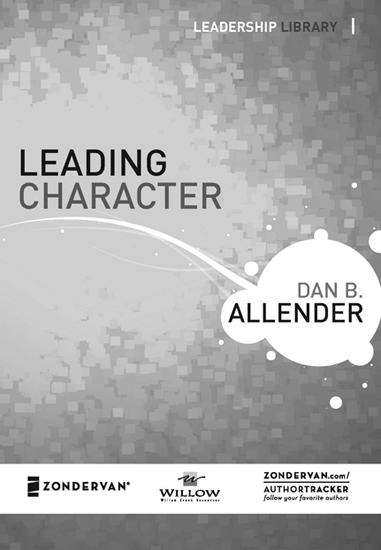
Leading Character
Also by Dan B. Allender
Encouragement
The Wounded Heart
Bold Love
The Cry of the Soul
Intimate Allies
Breaking the Idols of Your Heart (with Tremper Longman III)
Bold Purpose
The Healing Path
How Children Raise Parents
The Intimate Mystery
Leading with a Limp
To Be Told


Leading Character
ePub Format
Copyright 2008 by Dan B. Allender
Requests for information should be addressed to:
Zondervan, Grand Rapids, Michigan 49530
ISBN 0-310-30898-4
All Scripture quotations, unless otherwise indicated, are taken from the Holy Bible: New International Version. NIV. Copyright 1973, 1978, 1984 by International Bible Society. Used by permission of Zondervan. All rights reserved.
Scripture quotations marked TNIV are taken from the Holy Bible, Today's New International Version. TNIV. Copyright 2002, 2004 by International Bible Society. Used by permission of Zondervan. All rights reserved.
Scripture quotations marked NLT are taken from the Holy Bible, New Living Translation, copyright 1996. Used by permission of Tyndale House Publishers, Inc., Wheaton, Illinois 60189. All rights reserved.
Interior design by CHANGE Design Group
LEADERSHIP LIBRARY
The purpose of the Leadership Library is to provide leaders in all arenaschurches, businesses, schools, or nonprofitswith the cutting-edge thinking and the practical advice they need to take their leadership skills to the next level.
Books in the Leadership Library reflect the wisdom and experience of proven leaders who offer big insights in a pocket-size package. Whether you read these books on your own or with a group of colleagues, the Leadership Library presents critical insight into today's leadership challenges.
Leading Character
H ow did you first become a leader? Do you remember the circumstances? Maybe you earned an actual title to indicate you were the person in chargethe captain of the team, a candidate for public office, the CEO. Perhaps other people gravitated toward you naturally, counting on you for decisions and willingly following your lead. Or it's even possible that your leap into leadership resembled mineand came about more or less as a matter of default.
I was teaching at Mars Hill Graduate School, which was, at that time, a satellite school of Western Seminary in Portland, Oregon. We were, however, in the process of moving the school toward independence, and six of us who were on the faculty were involved in this transition. At one point, about three years into the process, we were required to complete and sign an accreditation document. And one of the blanks on that form required an answer to this question: Who is the president?
I'll never forget that meeting. When it got to the point where someone had to consent to list their name as the president, the room got very quiet. As we looked around at one another, it became clear no one was going to speak. We were all testing each other, waiting to see who would be foolish enough to agree to such a thing.
Eventually, we reached a consensus that because I was the oldest, I would take on that positionalthough no one, including me, expected that I would ever really act as the president.
That assumption continued until the moment when, about four months later, we faced our first dismissal of an employee. And with that responsibility, I may have become the only human being in history ever to fire the same person three times in less than twenty-four hours.
I fired him, providing due cause and asking him to think and pray about our conversation. At the end of our forty-five minutes of interaction, I said we would speak again the next day, never imagining he would go home and create an entire plan as to how he could enhance his performance and revise his job description. He came back eager for the opportunity to present his planand it was clear the firing had not taken effect.
I gathered enough wisdom and strength to fire him again. At that juncture, he asked, because of certain things he was doing, if he could stay another week to ten days to finish those projects. I considered that an enormously gracious suggestion on his part. How reasonable, I thought. So he went back to work.
Later that day, our receptionistwho had previously worked for a large corporationasked me, Is he still employed? Yes, I said, but just for another week to ten days.
At that point, she began to enumerate all the things this person had access to and explained how this could be very problematic if he harbored any kind of ill spirit toward the school. Well, I hadn't even thought of an ill spirit, much less the complications that could occur. She told me that in her previous job, when employees were asked to leave, the company allowed them an hour or so to go to their desks and gather all of their personal belongings. Then they were escorted out of the building.
It made sense! Which meant I had to fire him for the third time.
And that was only the beginning. In the years that followed, I made every classic mistake a leader can possibly make. Then I invented some I don't believe ever before existed on the face of the earth.
But every mistake became a lesson learned. And very often these hard-earned lessons prompted valuable conversations with other leaders. I began to see that certain patterns surround outstanding leadership. I noted, for example, how often the leaders I most admired are each widely known for their strong, highly regarded character. That is not to say that they are stodgy, unimaginative, play-it-by-the-book kinds of people. In fact, most are quite honest about their struggles in ministry and with the wars of leadership.
Yes, they have impeccable integrity, but they also make me laugh. They not only wow me with their individuality and spontaneity, they impress me with their meticulous honesty and forthrightness. They struggle and worry about their kids. While they are committed to their marriages, at times they feel lonely and need more support from their spouses. They are real, human, fully alive, and beautiful people.
Too often, leaders suppress such openness. What they are allowed to say from the platform or in conversations with others is narrowed down to the expected and tolerated, and all else must be hidden or denied. Such limitations create a degree of being two-facedone face public, the other private.
At times that hypocrisy is even internalized. When this happenswhen we deny the parts of ourselves that would cause disruption if they were seen or acknowledged in polite companywe are on shaky ground. Because no one can live long with such disparity without a loss of integrity.
No one is immune to the public-private face war. Sometimes the face we present in public requires immense courage; other times, the public face is an indication of great cowardice. Are you aware of when you have been courageous or cowardly? I pray that by reading and then reflecting on this material you will be encouraged to consider both possibilities.
Eventually, I came to realize that leadership is all about character. And that the Christian leader, no matter what he or she oversees, has the opportunity to be a leading characteran example, a living representation of the power of the resurrection and the privilege of the fellowship created by sharing in Christ's suffering.
Next page













